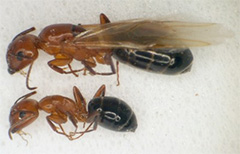ManageSafe
Least-Toxic Control of Carpenter Ants Choose a different pests

|
Factsheet: Least-toxic Control of Carpenter Ants
Identification
Pest type: Insects
In-depth Information:
Carpenter ants are important decomposers of decaying trees in forests, but, as one of the most efficient wood-destroying insects in the US, in our homes they are damaging, expensive pests.
These insects come in a variety of sizes and colors. They range from 7-15 mm long and can be red, red and black, or all brown. They have two distinguishing characteristics: they have only one node between their thorax and abdomen, and their thorax is evenly rounded in profile, with no spines. The damaged wood in carpenter ant nests has smooth, clean galleries that feel as if they have been polished with fine grit sandpaper. There will be no frass, sawdust, mud, mastic or any other debris in the nest. The galleries normally follow the grain of the wood and are excavated in the softer portions, with connecting passages through the harder wood. The galleries are wide and irregular in shape, and often have rounded edges. Carpenter ants often have multiple nest sites.
Unlike termites, which burrow into the wood to feed upon it, ants burrow only to construct their nests. Nests are often kept clean by ants pushing wood bits and other debris out of the nest through a crack or slit, called a “window,” into a dump pile of “frass.” Carpenter ants have distinctive dump piles. Since they are simply excavators, their frass is mostly small, irregular piles of wood and look very much like sawdust. The frass will also contain ant feces, bits of soil, gravel and other debris, leftover pieces of their food (seed coats and the indigestible parts of other insects), and dead carpenter ants.
Carpenter ants will usually nest in water-damaged or softened, decaying wood – where there have been plumbing leaks, where wood has been repeatedly soaked by rain or condensation or where wood meets soil. They often begin their nests in decayed wood and then move to dry, sound wood. They can also nest in insulation or small voids.
Is it a problem?
Carpenter ants damage wood by excavating and creating galleries and tunnels. These areas are clean, i.e. they do not contain sawdust or other debris, and are smooth, with a well sanded appearance.
The damage to wood structures is variable but the longer a colony is present in a structure, the greater the damage. Therefore, take measures to control carpenter ants at the first signs of infestation.
Pest prevention practices
Remove potential habitat
In-depth Information:
Reduce moisture within the structure. Repair all roof and window leaks. Adequately ventilate damp areas such as basements and crawl spaces. Properly grade soil around the home to drain water away from the structure. Prune tree and bush branches so they are not against the house walls. When doing repairs or creating new structures, use a naturally resistant wood such as cedar, cyprus or jarrah.
Monitoring and record-keeping
- Watch the ants to find the location of their nest. Use jelly or honey as bait to find entrances in walls.
- Ascertain the extent of the infestation. You can hire a pest control company to do this, but make sure you are not obligated to enter a treatment contract along with the inspection.
- You can also conduct your own inspection. Use a flashlight to inspect the entire structure. Look for signs of wood boring activity such as sawdust, cracks, holes and mildew, as well as frass (insect droppings).
- Use a screwdriver to carefully probe suspicious looking hollow places.
- Determine if the infestation is active. How fresh are the frass and sawdust? If you spot live ants, you definitely have an active infestation
Non-chemical and mechanical controls
Repair holes
Remove water source: check drains, faucets and pipes
Heat
In-depth Information:
Since carpenter ants can only survive in a narrow temperature range, manipulation of temperature provides a non-toxic control method. Various control companies may offer to tent and heat the house, or provide an alternative freezing method.
Biological controls
Unfortunately, biological controls are not effective for control of indoor carpenter ants.
Least-toxic chemical options as a last resort
- Boric acid provides a least toxic alternative for control, but must be handled with care since it is still a poison.
- Insecticidal dusts such as silica gel and diatomaceous earth are another least toxic option. Beware that some varieties of these products contain pyrethrins. When applying insecticidal dusts be sure to wear gloves, goggles, and breathing mask. Do not apply insecticidal dusts where there might be water runoff, as these chemicals are toxic to fish.
Chemicals to Avoid
Look at your product labels and try to avoid products containing those chemicals listed below:
(A = acute health effects, C = chronic health effects, SW = surface water contaminant, GW = ground water contaminant, W = wildlife poison, B = bee poison, LT = long-range transport)
|
Bifenthrin Carbaryl Chlorfenapyr | Cyfluthrin Cypermethrin Deltamethrin | Fipronil Lambda-cyhalothrin Permethrin | Prallethrin Pyrethrins |
Social Media
See what other folks are saying about this, and let us know what works for you.
Crunching Carpenter Ants: Welcome Back to Question of the Week!Question:Help! I saw a carpenter ant lurking in my...
Posted by Beyond Pesticides on Friday, October 30, 2015
Click the post above to view and comment on Facebook, or comment directly on this site below.








